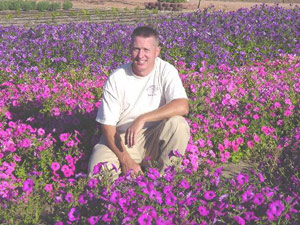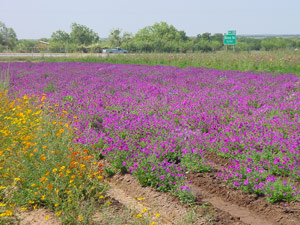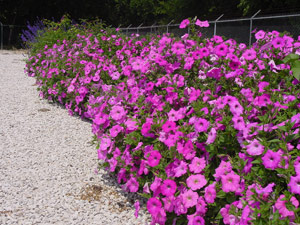The Making of a Texas Superstar - And how a new petunia got its name.
By
Steve Farrell, Smith County Master Gardener
as told by
Greg Grant, Texas A&M AgriLife Extension Service, County Extension Agent—Horticulture, Smith County, Tyler, Texas
In early 1998 Nacogdoches city leaders learned that Laura Bush, First Lady of Texas at that time, planned to visit the city to view the newly renovated town square. A University official asked Dr. David Creech, Director of SFA Gardens, if there was any unnamed plant that could be named after her. Dr. Creech contacted Greg Grant, at that time an instructor and part time plant developer, who explained that he didn’t have a whole greenhouse full of unnamed plants waiting to be named. It was far from that simple. After discussing with his mentor and co-plant developer Dr. Jerry Parsons with the Texas A&M AgriLife Extension Service in San Antonio it was decided that a petunia Greg and Jerry had been working on and calling ‘Jr. Petunia’ would be used.
Creation of a new plant cultivar doesn’t happen overnight. It’s a complex and time-consuming process. The process commonly known as “selection” normally requires:
- Seeds or tissues from plants with promising and desired characteristics are collected.
- They are planted and propagated in a nursery to confirm desired traits.
- Pollen is collected and the different plants are cross pollinated.
- Recurrent selection of newly propagated plants occurs following the desired traits in multiple generations of harvesting the seeds, replanting, and reselecting to evolve a plant in which the desired traits are common.
| Greg Grant, Texas born, a renowned horticulturist, plant inventor, writer, lecturer, and story teller had a passion for old fashioned, heirloom plants and an obsession for developing plants that could survive on their own in the demanding Texas environment. Greg had discovered a tough little “V.I.P.” petunia (Very Important Petunia) at a horticulture exposition in Stuttgart, Germany in 1993. At the time he was director of product development for Color Spot Growers. He brought back seeds from the “V.I.P.” to Texas. Seedlings were germinated from the “V.I.P.” and grown to plants. |

Greg Grant with Laura Bush petunia selections |
In 1994 pollen was taken from the “V.I.P. petunia and deposited into a white old-fashioned petunia that was provided by Dr. William C. Welch, another of Greg’s Texas A&M AgriLife mentors and Southern Heirloom Garden co-author. Seeds were harvested from the old-fashioned petunia mother, and seedling offspring were germinated combining the genetic traits of the old-fashioned petunia mama and the “V.I.P” papa plants. They were planted in the San Antonio Botanical Garden.

Pink Laura Bush Petunia harvest on June 20, 2005 |
On a hot day in June 1996, 20 selections of the plants were collected by Greg Grant and propagated from cuttings by Dr. Jerry Parsons at the Peterson Bros. Wholesale Nursery in San Antonio. The rooted cuttings were transplanted to the Verstuyfts vegetable farm near Von Ormy, Texas. Earlier generations of Verstuyfts had been flower growers in Belgium. By July more than half the plants had been eliminated by the summer heat and a frigid January norther finished off the rest, except for 3 plant selections. Dr. Parsons, collected seeds from the 3 surviving selections, propagated, replanted, and subjected them to continued field torture and reselection. |
By the spring of 1998, little multiflora ‘Jr. Petunia’ with the large and plentiful glowing violet blooms; super hearty enough to withstand the harsh Texas environment, was ready for its debut. The newly named ‘Laura Bush’ petunia, by this time 5 years in the making, would be the showcase for the recently renovated Nacogdoches town square and the name sake for the Texas First Lady.
Greg Grant has introduced more than 50 plants: roses, phloxes, salvias, verbenas, gardenias, petunias and others. In his own style he names his newly developed plants for friends, colleagues, grandparents, beloved dogs and names on cemetery headstones. So why not name an old fashioned, true from seed, fragrant violet bloomer after one of the most respected First Ladies of our time!
Interestingly enough, Dr. Dave Creech, a self-proclaimed “yellow dog Democrat” presented the petunia to Laura Bush on the downtown square on her visit to Nacogdoches.
The ‘Laura Bush’ Petunia was immediately submitted to extensive field testing in four regions of the state. By the end of 1999, it was certified as a Texas Superstar which means it will show superior performance under Texas tough growing conditions in the Earth-Kind™ landscape.

Laura Bush petunia at President George Bushs Crawford Ranch |
It is reported that the ‘Laura Bush’ Petunia flourished at the Washington, D.C. Whitehouse as well at other State executive residences, and in gardens at Camp David, Maryland, as well as at the Bush ranch in Crawford, Texas, which would indicate that it can also be hearty in cooler more humid climates. Dr. Jerry Parsons subsequently “selected” a pink variety which is available from Wildseed Farms Wildflowers near Fredericksburg, Texas (‘Laura Bush’ Petunia Pink – 8860) Regular price $3.19
|
Both colors are available from John Thomas’ Wildseed Farms (www.wildseedfarms.com) in Fredericksburg, Texas. The availability of ‘Laura Bush’ Petunia selections is the first time that a reseeding, old-fashioned petunia seed have been available for sale.
Wildseed Farms
‘Laura Bush’ Petunia - 8882
Regular price $3.19 per package
|

Left to Right -- John Thomas, Greg Grant and Jerry Parsons |
The Wildseed Farms Catalog at:
https://www.wildseedfarms.com/products/laura-bush-petunia?_pos=1&_sid=4ae16d8ec&_ss=r&variant=33577323524 reads:
Petunia X violacea (Solanaceae)
A hardy, reseeding annual variety native to South America. This rugged old-fashioned petunia variety was bred for heat tolerance and disease resistance. The Laura Bush Petunia scoffs at extreme summer temperatures, producing numerous 1 - 1 ½ inch bell-shaped violet colored flowers. As the mercury rises in the dog days of summer, this baby literally cranks out the blooms. As an added bonus the dark green foliage serves as a background to compliment the vibrant flowers that practically glow. Prefers full sun in well drained, fertile soil. Very low maintenance and quite impressive!
Direct sow in early spring after the danger of frost has passed.
Suggested Use: Wooded barrels, borders, hanging baskets.
Miscellaneous Use: Flowers are delightfully fragrant. Reseeds. If started in flats, space transplants 12 inches apart. Soil temperatures below 68°F will limit germination response. Requires a minimum of 7 hours of direct sun or plants will become spindly and have fewer blooms.
Average Planting Success: 70 percent
Height: 8 - 24 inches
Germination: 15 - 30 days
Optimum Soil Temp. for Germination: 68 degrees F. – 86 degrees F.
Sowing Depth: Surface Sow
Blooming Period: April - First Frost
Average Seeds Per Pound: 6,549,000
Seeds/Pkt: 200 Covers 30 sq.ft.
1 ounce covers 2,723 square feet
Seeding Rate: 1 pound per acre

Original field planting at Verstuyft Farms on July 16, 2001
|

Original field planting at Verstuyft Farms with Cosmos
|

Pink Laura Bush
|

Pink Laura Bush petunia with moth
|

Pink Laura Bush petunia on May 16, 2001
|

Pink Laura Bush petunia on May 23, 2001
|
| |

Pink Laura Bush petunias on May 3, 2005, in San Antonio
|
|
|



